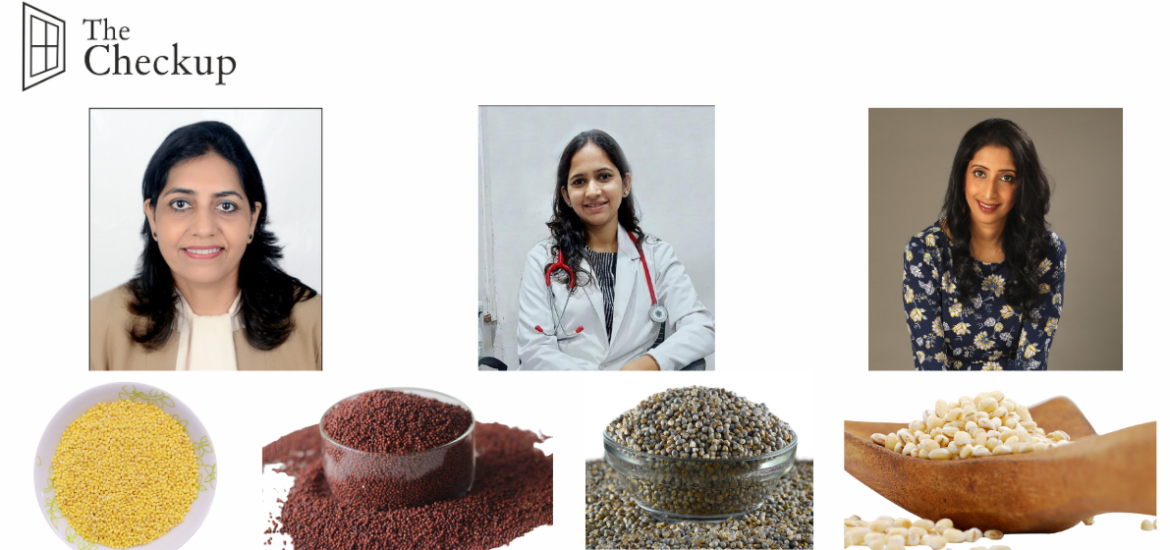“Let food be thy medicine and medicine be thy food.”
~Hippocrates.
This World food day, The Checkup catches up with our leading Nutrition counsellors to shed light on the ‘World of Millets’ and the easiest ways to include them in our daily diet.
“The Millet Revolution: A Prescription for Health”
In March 2021, during its 75th session, the United Nations General Assembly officially declared 2023 as the International Year of Millets (IYM 2023). This initiative, denoted by the hashtag (IYM2023), aims to spotlight the nutritional and health benefits of millets and their adaptability to adverse and changing climate conditions.
Historically, millets were a primary dietary staple in India. However, their importance diminished over time, particularly after the Green Revolution.
Millets are a category of small-grained, warm-weather cereals that belong to the grass family. In India, significant millets include Jowar (Sorghum), Bajra (Pearl Millet), and Ragi (Finger Millet). Additionally, smaller millets like Proso (Cheena), Kodo (Kodra, Arikelu), Foxtail (Kangni/Korra), Barnyard (Varai, Sawa), and Little millet (Kutki) are also cultivated.
Given the rising concerns about lifestyle-related diseases and a growing interest in nutrient-rich foods, consumers need to gradually turn to millets as a viable and nutritious alternative to traditional staples like wheat and rice.
Millets are a rich source of Nutrients like Proteins, energy, fibre, magnesium, niacin, antioxidants and prebiotics.
Millet and millet based products are known to have lower starch and protein digestibility rates when compared to other cereals. Factors such as starch structural characteristics, starch- protein-lipid interactions, fiber and polyphenols present in millets play significant roles in their hypoglycemic property. The amount and type of fatty acids present in millets significantly affect their starch hydrolysis rates.
The nutritional bioavailability of millets is crucial because it determines how well the nutrients they contain can be absorbed and used by our bodies. This is more important than just the amount of nutrients in the food itself.
Millets are known to be rich in minerals, but they also have anti-nutrients like phytates, polyphenols, and tannins that can reduce the absorption of these nutrients in our bodies. Both the way we prepare millets and how our bodies work can affect how well we can use the nutrients in millets. So, the goal is to reduce the levels of anti- nutrients and increase the nutrient content. How millets are processed has a significant impact on how nutritious they are for us to eat.
One way to process millets is using machines and traditional methods. Mechanical techniques involve processes like removing the outer layer of the grain (decortication), milling the grains into flour, and sieving. Traditional techniques like germination, fermentation, malting, popping, and soaking and cooking are used to improve the taste, nutritional value, and overall quality of millets.
Millets can be added to regular diet with traditional and innovative recipes like Ragi Mudde, Kodo uttapam, Pithe (Ragi flour pancake), Sprouted Mixed Millet Paniyaram (Appe),Ragi Puttu, Foxtail Millet Manoharam, Millet Biryani, Khichdi, Finger Millet Chimili, Millet Porridge, Aambil, Pongal, Dosa, Foxtail millet or Thinai Murukku, , Kodo Millet sherbet or Milk shake, Smoothie, Fritters, cutlets, Kheer, Soup stics, cookies, Breakfast Bars, Millet halwa, Laddu.
Embracing millets in our daily meals not only promises a wealth of health advantages but also opens up a world of delectable and diverse culinary possibilities. From millet-infused biryanis and dosas to comforting khichdi and nourishing porridge, millet-based recipes offer a delightful culinary journey. With the International Year of Millets (IYM 2023), it a chance to not just acknowledge the immense potential these ancient grains possess but also relish the remarkable tastes and textures they bring to our dining experience.
As we become more aware of their nutritional richness and their ability to thrive in our changing world, millets are more than just a passing food fad; they represent a sustainable and nutritious choice for the future. So, let& celebrate the resurgence of millets, a nutritional and culinary heritage that truly a reason for enthusiasm!

How best to include millets in everyday life?
In an alarming report published by International Diabetes Federation in 2022, researchers state that patients with Diabetes Mellitus type 1, are on a rapid rise all over the world. Still more alarming is the fact that, majority of newer patients are children.
The nutritional value of the food we eat today has decreased grossly and it has led to many diseases, various nutritional deficiencies, and lowering of immunity.
Millets have been a major contributor to the Indian culture since around 7000 years!
Let’s check out how we could include these traditionally used, and nutritious millets in our modern diet.
Commonly used Millets:
Jowar (sorgham)
Bajra (pearl millet)
Vari (little millet)
Kodu (ricegrass)
Rajgira (Amaranth)
Rala (foxtail millet)
Kang (miracle millets)
Sava (barnyard millet)
Nachni (red millet)
Advantages of Millets in the children’s diet:
Children these days, consume a lot of rice and wheat in various forms. Modern food culture, demands polished and long grained rice (the process, sapping the nutritional value)
On the contrary, if millets are compared to rice, the former contain three times more proteins and more amount of carbohydrates, fibres, antioxidants, and essential amino acids, thus, making them a full package of complex carbohydrates!
A Research showed that children consuming more millets, grow 28.3% more, than those having more of wheat. Millets help in controlling the menarche related health issues in adolescent girls.
Millets are gluten- free thereby reducing acidity. On the other hand, refined wheat flour (maida) has lot of side effects. Children have a very delicate digestive system and use of gluten- free and easily digestible millets is therefore the food of choice.
Millets have lesser glycemic index than wheat helping in regulating the sugar levels and keeping insulin spike in check.
They contain lactic acid which is essential for useful bacteria of the gut, thus improving digestion.
Millets, as whole grains are consumed with the nutritious husk, maintaining the fibre quantity, giving satiety after consumption, reducing the urge of over-eating, and regulating body weight.
Millets contain essential minerals (calcium, iron, zinc, phosphorus, magnesium, potassium), folic acid and vitamin B6 and are a good source of lecithin which is essential for proper functioning of the nervous system.
To summarise, millets are super foods, easily digestible by all age groups, right from 6 month old babies, to geriatric people, in their 90s
Values of good eating have to be imbibed into the young. We can bring a small but interesting ‘twist’ to the children’s favourite foods and make them savour millets by offering them interesting, intelligently cooked, millet containing ‘favourites’!
Tips to include millets:
Chapati and bhakri can be made by adding bajari, nachni ,jwari, rajgira .
During religious fasts, we can replace sago with ‘vari’, to make khichdi. Rice can be replaced by ‘vari’.
7 month olds, can be fed with ‘nachni’, ‘ragi’, ‘vari’ ‘nachni’ ‘sattu’ (porridge).
Sprouted millets can be used to make ‘usal’ and salads.
Children love to eat items like laddoos, pizza, burgers, idli , dosa, amboli ,Frankie, thalipith, noodles, bhel, soups, etc.
Besan can be replaced by millet flours for laddoos.
Pizza bases can be made more of millets flour and less of ‘maida’ can be used.
Patties used in burgers, can be made from millet flour and sprouted millets.
Idli, dosa, amboli, can be made with millets.
Corn flakes, choco flakes, can be mixed with ‘nachni’, ‘bajri’ flour to make mixed flakes .
Bhel can be made from puffed grains of ‘bajri’ , ‘nachni’ ‘jwari’ ‘vari’.
Soups can be mixed with one or two teaspoons of roasted millets flour .
Like-wise, combining modern dishes, with traditional millets and making *hybrid favourites*, can be easily accepted by children. (Taste bhi, health bhi!!!)
Words of caution:
‘Bajari’ , ‘vari’ contain Goitrogens, which interfere with production of thyroid hormone. So people having thyroid problems should avoid these .
‘Nachni’ should be avoided in children having constipation and kidney stones.
Our great nation has been bestowed upon, by such a great food culture since ages.
Let us rejuvenate the same, and create a path of health and fitness for the Gen-next!

Dr.Gargi Gaurav Oraskar
BHMS, PG Diploma in Diet and Nutrition , Master’s in Sports Nutrition and Exercise, and Diabetes educator. Gmail : foodandbeyond23@gmail.com
Millets made Easy
Millets, once a forgotten grain in many parts of the world, are making a remarkable comeback. These tiny powerhouses of nutrition have been a staple in Indian diets for centuries, and their resurgence in popularity is well-deserved. Millets offer a wide range of health benefits and are incredibly versatile in the kitchen. In this article, we’ll explore the many ways to incorporate millets into your daily life.
Why Millets?
Before diving into how to include millets in your everyday life, it’s crucial to understand why they deserve a place in your pantry. Millets are a group of small-seeded grasses cultivated for their grains, which come in various types, including Jawar, Bajra, Ragi, Vari, Rajgeera and Kuttu. Here’s why they are a nutritional powerhouse:
- Rich in Nutrients: Millets are an excellent source of essential nutrients such as fiber, vitamins, and minerals. They are particularly high in magnesium, a mineral that is essential for various bodily functions, including heart health and bone strength.
- Gluten-Free: If you have celiac disease or gluten sensitivity, millets are an ideal choice. They are naturally gluten-free, making them a safe option for those with dietary restrictions.
- Low Glycemic Index: Millets have a low glycemic index, which means they help regulate blood sugar levels, making them a wise choice for individuals with diabetes.
- High in Fiber: The high fiber content in millets aids digestion, helps maintain a healthy weight, and lowers the risk of chronic diseases like heart disease and type 2 diabetes.
- Antioxidant Properties: Millets contain various antioxidants that help protect your cells from damage caused by free radicals, reducing the risk of chronic diseases and premature aging.
Now that we understand the numerous health benefits of millets, let’s explore how you can include them in your daily life.
Ways to Include Millets in Everyday Life
- Substitute Rice or Wheat: One of the easiest ways to incorporate millets is by using them as a substitute for rice or wheat. Millet grains can be cooked and served just like rice. Try replacing a portion of your usual rice with millets for a healthier and more nutrient-rich meal.
- Millet Porridge for Breakfast: Start your day with a nutritious breakfast by preparing millet porridge. Simply cook millet grains in water or milk, and top it with your favorite fruits, nuts, and a touch of honey or maple syrup.
- Millet Flour: Millet flour can mixed with other flours to make rotis, bhakris, dosas, or pancakes for added variety in taste and nutrition.
- Millet Salad: Toss cooked millet grains with fresh vegetables, herbs, and a light dressing to create a refreshing and nutritious salad.
- Millet Soup: Millet grains can be used in both clear broths and creamy soups to add a hearty texture and flavor.
- Millet Idli or Dosa: In South India, millets are often used to make idlis and dosas. You can prepare these traditional dishes using millet batter for a healthier twist.
- Millet Pulao: Cook millets with vegetables, herbs, and spices to create a flavorful pulao as an alternative to traditional biryani.
Recipe: Millet and Vegetable Biryani
Now, let’s dive into an Indian-inspired recipe that showcases the incredible versatility of millets.
Ingredients:
– 1 cup mixed millets soaked overnight
– 2 cups mixed vegetables (carrots, peas, bell peppers, beans, etc.)
– 1 large onion, thinly sliced
– 2 tomatoes, chopped
– 2 tablespoons ghee or oil
– 1 cinnamon stick
– 2-3 green cardamom pods
– 4-5 cloves
– 1 bay leaf
– 1 teaspoon cumin seeds
– 1 teaspoon ginger-garlic paste
– 1/2 teaspoon turmeric powder
– 1 teaspoon biryani masala
– 1/2 teaspoon red chili powder (adjust to taste)
– Salt to taste
– 2 cups water
– Fresh coriander leaves and fried onions for garnish
Instructions:
- Heat ghee or oil in a large pan. Add the whole spices and sauté for a minute until they release their aroma.
- Add the sliced onions and sauté until they turn golden brown.
- Stir in the ginger-garlic paste and cook for a couple of minutes until the raw smell disappears.
- Add the chopped tomatoes and cook until they become soft and mushy.
- Add the mixed vegetables, turmeric powder, biryani masala, red chili powder, and salt. Sauté for a few minutes until the vegetables start to cook.
- Now, add the soaked and drained millets. Mix well with the vegetable and spice mixture.
- Pour in the water and bring the mixture to a boil. Once boiling, reduce the heat to low, cover the pan, and let it simmer for about 15-20 minutes, or until the millets are cooked and the water is absorbed.
- Once the millets are cooked, fluff the biryani gently with a fork. Garnish with fresh coriander leaves and fried onions.
- Serve your Millet and Vegetable Biryani hot with raita or a side salad.

- Education: Post Graduate Diploma in Dietetics and Applied Nutrition. And Masters Degree (M.Sc.) in Food Science and Clinical Nutrition from Nirmala Niketan College of Home Science.
- Practicing as a Clinical Nutritionist & Dietician in Mumbai : Vile Parle.
- Consultant to a CRO – Clinical Research Organisation in Designing and Conducting Clinical Trials.
- Consultant to a Health Care Marketing & Communication company.
- Regularly contributes articles in various newspapers, magazines, journals on Diet & Health. Co-authored a book on Health.
- Consultant to Health Food Companies for new Product development, Consumer Interaction and Marketing.
- Conducts talks, seminars in schools, colleges and community.
- Worked as a Chief Nutritionist at the R&D centre of Marico Ind. Ltd.
- Examiner and Moderator for University of Mumbai M.Sc. Nutraceutical Board Examination.
References:
https://www.nabard.org/international-year-of-millets-2023.aspx
https://www.fao.org/millets-2023/en
George Amponsah Annor, Catrin Tyl, Massimo Marcone, Sanaa Ragaee, Alessandra Marti,Why do millets have slower starch and protein digestibility than other cereals?, Trends in Food Science & Technology,Volume 66,2017,Pages 73-83,ISSN 0924-2244,https://doi.org/10.1016/j.tifs.2017.05.012.









